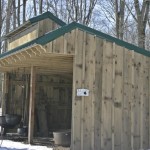This three-sided hemlock sided structure was built here to enhance the Walking Trail, and to illustrate a type of basic lean-to used by exploring pioneers as basic shelter. These structures were later popularized by Adirondack Mountain guides, in upstate New York, for fishing or hunting parties.
Settlers used giant iron pots to make syrup and then smaller ones to stir maple sugar. When explorers, traders and pioneers arrived in America, native people already had well-established methods for turning sap into sugar – that’s why we call the place where syrup is made, a sugarhouse! These Native Americans would have traded items with the settlers so they too could enjoy having an iron pot. Records from the mid-1700’s indicate wide use of sap as a social and medicinal drink. In the colonies, maple sugar was more available and less expensive than the heavily taxed cane sugar coming in from the West Indies and, unlike cane sugar, maple sugar was not produced with slave labor. Our third president, Thomas Jefferson, thought that if we were to be truly independent of Great Britain we should produce maple sugar and plant maple trees. Syrup was boiled down to make maple sugar crumb, cakes or loaves for easy storage. This sugar was traded, bartered, sold and used year ‘round in American households.
No wonder maple sugar was the main sweetener used in America for nearly two hundred years.
Annually, pioneers celebrated “sugaring-off-time” with sugar-on-snow parties, sugar-stirs, and taffy pulls. Hurry Hill celebrates “the coming of spring” with hot cocoa made with maple sap, plus hotdogs, even eggs, boiled in sap. Native Americans celebrated the sugar month, or Maple Moon, with ceremonies and dancing.
(Use the Walking Trail sub-menu above to navigate to other stops on the trail)

